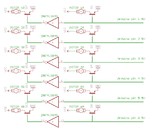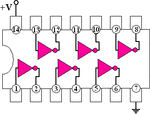amirox
Newbie level 3
I want to invert a single coming from each pin of my arduino board. The goal is to keep motor Q2 running until a signal from PIN 1 is pulled up. In that case Motor Q2 must turn off and Motor Q2 turn on.
Here is my schematic made by a friend:

I am using SN74LS04 (Hex Inverter) that gives me 6 pairs of input output pins:

For some reason I can not get it to work. Instead of the motors and transistors I am using LED lights for testing. Vcc and Ground pins of the Inverter is connected to 5v pin and GND pin of arduino. Before going further, I read 1.2v on all input pins of the inverter (ie pin 1), and 0.15v on outputs (ie pin2).
Connecting 5v to the inputs does not make any difference in the output!!! I am confused. I was PIN2 (output) to be high unless I pull up PIN1 (input).
Any idea?
Thx for reading.
Here is my schematic made by a friend:

I am using SN74LS04 (Hex Inverter) that gives me 6 pairs of input output pins:

For some reason I can not get it to work. Instead of the motors and transistors I am using LED lights for testing. Vcc and Ground pins of the Inverter is connected to 5v pin and GND pin of arduino. Before going further, I read 1.2v on all input pins of the inverter (ie pin 1), and 0.15v on outputs (ie pin2).
Connecting 5v to the inputs does not make any difference in the output!!! I am confused. I was PIN2 (output) to be high unless I pull up PIN1 (input).
Any idea?
Thx for reading.